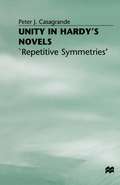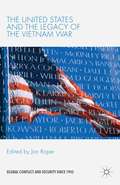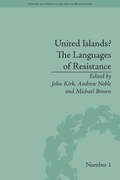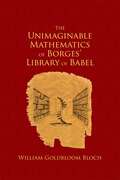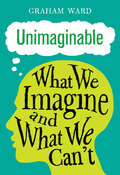- Table View
- List View
The Unity of Content and Form in Philosophical Writing: The Perils of Conformity (Bloomsbury Studies in Philosophy)
by Jon StewartIn The Unity of Content and Form in Philosophical Writing, Jon Stewart argues that there is a close relation between content and form in philosophical writing. While this might seem obvious at first glance, it is overlooked in the current climate of Anglophone academic philosophy, which, Stewart contends, accepts only a single genre as proper for philosophical expression. Stewart demonstrates the uniformity of today's philosophical writing by contrasting it with that of the past. Taking specific texts from the history of philosophy and literature as case studies, Stewart shows how the use of genres like dialogues, plays and short stories were an entirely suitable and effective means of presenting and arguing for philosophical positions given the concrete historical and cultural contexts in which they appeared. Now, Stewart argues, the prevailing intolerance means that the same texts are dismissed as unphilosophical merely due to their form, although their content is, in fact, profoundly philosophical. The book's challenge to current conventions of philosophical is provocative and timely, and will be of great interest to students and scholars of philosophy, literature and history.
Unity in Diversity: Current Trends in Translation Studies
by Lynne Bowker Michael Cronin Jennifer Pearson Dorothy KennyTranslation studies as a discipline has grown enormously in recent decades. Contributions to the discipline have come from a variety of fields, including machine translation, history, literature, philosophy, linguistics, terminology, signed language interpreting, screen translation, translation pedagogy, software localization and lexicography. There is evidently great diversity in translation studies, but is there much unity? Have the different branches of translation studies become so specialized that they can no longer talk to each other? Would translation studies be strengthened or weakened by the search for or the existence of unifying principles? This volume brings together contributions from feminist theory, screen translation, terminology, interpreting, computer-assisted translation, advertising, literature, linguistics, and translation pedagogy in order to counter the tendency to partition or exclude in translation studies. Machine translation specialists and literary translators should be found between the same book covers, if only because the nomadic journeying of concepts is often the key to intellectual discovery and renewal. Celebrating our differences does not mean ignoring what we have in common. Unity in Diversity offers a valuable overview of the current state of translation studies from both theoretical and practical perspectives and makes an important contribution to debates on the future direction of translation studies.
Unity in Diversity: Current Trends in Translation Studies
by Lynne Bowker Michael Cronin Jennifer Pearson Dorothy KennyTranslation studies as a discipline has grown enormously in recent decades. Contributions to the discipline have come from a variety of fields, including machine translation, history, literature, philosophy, linguistics, terminology, signed language interpreting, screen translation, translation pedagogy, software localization and lexicography. There is evidently great diversity in translation studies, but is there much unity? Have the different branches of translation studies become so specialized that they can no longer talk to each other? Would translation studies be strengthened or weakened by the search for or the existence of unifying principles? This volume brings together contributions from feminist theory, screen translation, terminology, interpreting, computer-assisted translation, advertising, literature, linguistics, and translation pedagogy in order to counter the tendency to partition or exclude in translation studies. Machine translation specialists and literary translators should be found between the same book covers, if only because the nomadic journeying of concepts is often the key to intellectual discovery and renewal. Celebrating our differences does not mean ignoring what we have in common. Unity in Diversity offers a valuable overview of the current state of translation studies from both theoretical and practical perspectives and makes an important contribution to debates on the future direction of translation studies.
Unity and Diversity in Language Use (British Studies in Applied Linguistics)
by Kristyan Miller Paul ThompsonThe papers in this collection, drawn from the 34th Annual Conference of the British Association for Applied Linguistics, reflect a number of different perspectives within the field of applied linguistics at the start of the twenty-first century. While addressing the theme of unity and diversity, each paper prompts critical reflection on tensions within the discipline between stability and change, consensus and controversy, similarity and variation. The interpretation of language use is broad and varied, taking both macro- and micro-perspectives. Topics addressed range from issues of global communication in a world of shifting demographies and technological advances to analyses of specific contexts of interaction, both professional and personal. Contexts of language use frequently coincide with settings of language acquisition, both within and beyond the language classroom, and this opens up discussion of the focus, scope and appropriateness of research stances in applied linguistics and practices in language pedagogy. Furthermore, variation is considered from a number of social-cultural, gender-related, linguistic and discourse perspectives, calling into question terminology, definitions and the nature of evidence at the heart of applied linguistic theory and practice.
The United States of English: The American Language from Colonial Times to the Twenty-First Century
by Rosemarie OstlerThe story of how English became American -- and how it became Southern, Bostonian, Californian, African-American, Chicano, elite, working-class, urban, rural, and everything in between By the time of the Revolution, the English that Americans spoke was recognizably different from the British variety. Americans added dozens of new words to the language, either borrowed from Native Americans (raccoon, persimmon, caucus) or created from repurposed English (backwoods, cane brake, salt lick). Americans had their own pronunciations (bath rhymed with hat, not hot) and their own spelling (honor, not honour), not to mention a host of new expressions that grew out of the American landscape and culture (blaze a trail, back track, pull up stakes). Americans even invented their own slang, like stiff as a ringbolt to mean drunk. American English has continued to grow and change ever since. The United States of English tells the engrossing tale of how the American language evolved over four hundred years, explaining both how and why it changed and which parts of the "mother tongue" it preserved (I guess was heard in the British countryside long before it became a typical Americanism). Rosemarie Ostler approaches American English as part of the larger story of American history and culture, starting with what we know about the first colonists and their speech. Drawing on the latest research, she explores the roots of regional dialects, the differences between British and American language use, the sources of American slang, the development of African American English, current trends in political language, and much more. Plentiful examples of the American vernacular, past and present, bring the language to life and make for an engaging as well as enlightening read.
The United States of English: The American Language from Colonial Times to the Twenty-First Century
by Rosemarie OstlerThe story of how English became American -- and how it became Southern, Bostonian, Californian, African-American, Chicano, elite, working-class, urban, rural, and everything in between By the time of the Revolution, the English that Americans spoke was recognizably different from the British variety. Americans added dozens of new words to the language, either borrowed from Native Americans (raccoon, persimmon, caucus) or created from repurposed English (backwoods, cane brake, salt lick). Americans had their own pronunciations (bath rhymed with hat, not hot) and their own spelling (honor, not honour), not to mention a host of new expressions that grew out of the American landscape and culture (blaze a trail, back track, pull up stakes). Americans even invented their own slang, like stiff as a ringbolt to mean drunk. American English has continued to grow and change ever since. The United States of English tells the engrossing tale of how the American language evolved over four hundred years, explaining both how and why it changed and which parts of the "mother tongue" it preserved (I guess was heard in the British countryside long before it became a typical Americanism). Rosemarie Ostler approaches American English as part of the larger story of American history and culture, starting with what we know about the first colonists and their speech. Drawing on the latest research, she explores the roots of regional dialects, the differences between British and American language use, the sources of American slang, the development of African American English, current trends in political language, and much more. Plentiful examples of the American vernacular, past and present, bring the language to life and make for an engaging as well as enlightening read.
The United States and the Legacy of the Vietnam War (Global Conflict and Security since 1945)
by J. RoperVietnam precipitated a crisis in national self-confidence and a breakdown in political consensus out of which new ideological perspectives emerged. This book offers fresh perspectives on a defining event in 'the American Century', examining its historical and political significance and also its continuing cultural relevance.
The United States, 1865-1920: Reuniting a Nation (Seminar Studies)
by Adam BurnsThe United States, 1865–1920: Reuniting a Nation explores how the U.S. attempted to heal Civil War-era divisions, as well as maintain and strengthen its unity as new rifts developed in the conflict’s aftermath. Taking a broadly thematic approach to the period, Adam Burns examines the development of the United States from political, social, and foreign relations perspectives. Concise and accessible, the volume uses a variety of primary source documents to help stimulate discussion and encourage the use of historical evidence as support for different interpretations of the era. By exploring controversies over issues such as citizenship, ethnicity, regionalism, and economic disparity, all of which resonate strongly in the nation’s political discourse today, the book will be an important staple for undergraduate students of American History and the period that followed the Civil War, as well as general enthusiasts.
The United States, 1865-1920: Reuniting a Nation (Seminar Studies)
by Adam BurnsThe United States, 1865–1920: Reuniting a Nation explores how the U.S. attempted to heal Civil War-era divisions, as well as maintain and strengthen its unity as new rifts developed in the conflict’s aftermath. Taking a broadly thematic approach to the period, Adam Burns examines the development of the United States from political, social, and foreign relations perspectives. Concise and accessible, the volume uses a variety of primary source documents to help stimulate discussion and encourage the use of historical evidence as support for different interpretations of the era. By exploring controversies over issues such as citizenship, ethnicity, regionalism, and economic disparity, all of which resonate strongly in the nation’s political discourse today, the book will be an important staple for undergraduate students of American History and the period that followed the Civil War, as well as general enthusiasts.
The United Red Army on Screen: Cinema, Aesthetics And The Politics Of Memory (Palgrave Macmillan Memory Studies)
by Christopher PerkinsThis book investigates how films made about the URA since the 1990s have engaged with, reproduced and contested cultural memories of the organisation, discussing how directors have addressed questions of narrativization, trauma, intergenerational connection, and political subjectivity as they engage in the politics of cultural memory on screen.
United Islands? The Languages of Resistance (Poetry and Song in the Age of Revolution)
by John KirkThis is the first title in a new series called Poetry and Song in the Age of Revolution. This series will appeal to those involved in English literary studies, as well as those working in fields of study that cover Enlightenment, Romanticism and Revolution in the last quarter of the eighteenth century.
United Islands? The Languages of Resistance (Poetry and Song in the Age of Revolution #1)
by John KirkThis is the first title in a new series called Poetry and Song in the Age of Revolution. This series will appeal to those involved in English literary studies, as well as those working in fields of study that cover Enlightenment, Romanticism and Revolution in the last quarter of the eighteenth century.
Unitarian Radicalism: Political Rhetoric, 1770-1814
by Stuart AndrewsThe Unitarian confrontation with the late eighteenth-century political establishment is reflected in published sermons, pamphlets and parliamentary debates. Price and Priestley were only the most notorious members of a well-educated, close-knit and highly articulate intellectual opposition, all the more formidable for dominating the major literary reviews. Focusing on many lesser-known dissenting polemicists, this study uncovers unexpected continuities in Unitarian critiques of government policies an questions whether Burke was justified in equating antitrinitarians with French republicans.
The Unintended Reformation: How a Religious Revolution Secularized Society
by Brad S. GregoryIn a work that is as much about the present as the past, Brad Gregory identifies the unintended consequences of the Protestant Reformation and traces the way it shaped the modern condition over the course of the following five centuries. A hyperpluralism of religious and secular beliefs, an absence of any substantive common good, the triumph of capitalism and its driver, consumerism—all these, Gregory argues, were long-term effects of a movement that marked the end of more than a millennium during which Christianity provided a framework for shared intellectual, social, and moral life in the West. Before the Protestant Reformation, Western Christianity was an institutionalized worldview laden with expectations of security for earthly societies and hopes of eternal salvation for individuals. The Reformation’s protagonists sought to advance the realization of this vision, not disrupt it. But a complex web of rejections, retentions, and transformations of medieval Christianity gradually replaced the religious fabric that bound societies together in the West. Today, what we are left with are fragments: intellectual disagreements that splinter into ever finer fractals of specialized discourse; a notion that modern science—as the source of all truth—necessarily undermines religious belief; a pervasive resort to a therapeutic vision of religion; a set of smuggled moral values with which we try to fertilize a sterile liberalism; and the institutionalized assumption that only secular universities can pursue knowledge. The Unintended Reformation asks what propelled the West into this trajectory of pluralism and polarization, and finds answers deep in our medieval Christian past.
The Unimaginable Mathematics of Borges' Library of Babel
by William Goldbloom Bloch"The Library of Babel" is arguably Jorge Luis Borges' best known story--memorialized along with Borges on an Argentine postage stamp. Now, in The Unimaginable Mathematics of Borges' Library of Babel, William Goldbloom Bloch takes readers on a fascinating tour of the mathematical ideas hidden within one of the classic works of modern literature. Written in the vein of Douglas R. Hofstadter's Pulitzer Prize-winning Gödel, Escher, Bach, this original and imaginative book sheds light on one of Borges' most complex, richly layered works. Bloch begins each chapter with a mathematical idea--combinatorics, topology, geometry, information theory--followed by examples and illustrations that put flesh on the theoretical bones. In this way, he provides many fascinating insights into Borges' Library. He explains, for instance, a straightforward way to calculate how many books are in the Library--an easily notated but literally unimaginable number--and also shows that, if each book were the size of a grain of sand, the entire universe could only hold a fraction of the books in the Library. Indeed, if each book were the size of a proton, our universe would still not be big enough to hold anywhere near all the books. Given Borges' well-known affection for mathematics, this exploration of the story through the eyes of a humanistic mathematician makes a unique and important contribution to the body of Borgesian criticism. Bloch not only illuminates one of the great short stories of modern literature but also exposes the reader--including those more inclined to the literary world--to many intriguing and entrancing mathematical ideas.
Unimaginable: What We Imagine and What We Can’t
by Graham WardWhat we imagine can crush us or create us, destroy us or heal us; it can pitch us into battles with demons or set us among the songs of angels. It has roots beneath consciousness and is expressed in moods, rhythms, tones and textures of experience that are as much mental as physiological. In his new book, a sequel to the earlier Unbelievable, one of Britain's most exciting writers on religion here presents a nuanced and many-dimensional portrait of the mystery and creativity of the human imagination. Traversing landscapes that are both physical and emotional, palpable and intangible, the author enlists the company of fellow-travellers William Wordsworth, William Turner, Samuel Palmer and Ralph Vaughan Williams – alongside many other creative artists – to try to get to the bottom of the true meanings of originality and memory. Drawing the while on his own rich and varied encounters with belief, he asks why it is that the imagination is so fundamental to who and what we are. Using metaphor and story to unpeel the hidden motivations and architecture of the mind, and show what might lie beneath, Graham Ward grapples here with profound questions of ultimacy and transcendence. He reveals that, in understanding what it really means to be human, what cannot be imagined invariably means as much as what can.
Unimaginable: What We Imagine and What We Can’t
by Graham WardWhat we imagine can crush us or create us, destroy us or heal us; it can pitch us into battles with demons or set us among the songs of angels. It has roots beneath consciousness and is expressed in moods, rhythms, tones and textures of experience that are as much mental as physiological. In his new book, a sequel to the earlier Unbelievable, one of Britain's most exciting writers on religion here presents a nuanced and many-dimensional portrait of the mystery and creativity of the human imagination. Traversing landscapes that are both physical and emotional, palpable and intangible, the author enlists the company of fellow-travellers William Wordsworth, William Turner, Samuel Palmer and Ralph Vaughan Williams – alongside many other creative artists – to try to get to the bottom of the true meanings of originality and memory. Drawing the while on his own rich and varied encounters with belief, he asks why it is that the imagination is so fundamental to who and what we are. Using metaphor and story to unpeel the hidden motivations and architecture of the mind, and show what might lie beneath, Graham Ward grapples here with profound questions of ultimacy and transcendence. He reveals that, in understanding what it really means to be human, what cannot be imagined invariably means as much as what can.
A Unified Theory of Verbal and Nominal Projections (Oxford Studies in Comparative Syntax)
by Yoshiki OgawaSyntactically speaking, it has long been known that noun phrases are parallel to clauses in many respects. While most syntactic theories incorporate this principle, nouns have generally been regarded as inferior to verbs in terms of their licensing abilities, and nominal projections have been regarded as less complex than verbal projections in terms of the number of functional categories that they contain. Ogawa, however, argues that clauses and noun phrases are perfectly parallel. This book provides a unified theory of clauses and noun phrases, ultimately helping to simplify numerous thorny issues in the syntax/morphology interface.
A Unified Theory of Polarity Sensitivity: Comparative Syntax of Arabic (Oxford Studies in Comparative Syntax)
by Ahmad AlqassasPolarity sensitivity is a ubiquitous phenomenon involving expressions such as anybody, nobody, ever, never, somebody and their counterparts in other languages. These expressions belong to different classes such as negative and positive polarity, negative concord, and negative indefinites. In this book, Ahmad Alqassas proposes a unified approach to the study of this phenomenon that relies on examining the interaction between the various types of polarity sensitivity, with a particular focus on Arabic. Alqassas shows that treating this interaction is fundamental for scrutinizing their licensing conditions. Alqassas draws on data from Standard Arabic and the major regional dialects represented by Jordanian, Egyptian, Moroccan, and Qatari. Through the (micro)comparative approach, Alqassas explains the distributional contrasts with a minimal set of universal syntactic operations such as Merge, Move, and Agree. He also considers a fine-grained inventory of negative formal features for polarity items and their licensors. These simple features paint a complex landscape of polarity and lead to important conclusions about syntactic computation. By engaging with the rich but under-studied landscape of Arabic polarity sensitivity, this book provides a new perspective on the syntax-semantic interface and develops a unified syntactic analysis for polarity sensitivity. These contributions have important implications for the study of Arabic and for syntactic theory more generally.
UNIFIED THEORY OF POLAR SENSITIV OSCS C: Comparative Syntax of Arabic (Oxford Studies in Comparative Syntax)
by Ahmad AlqassasPolarity sensitivity is a ubiquitous phenomenon involving expressions such as anybody, nobody, ever, never, somebody and their counterparts in other languages. These expressions belong to different classes such as negative and positive polarity, negative concord, and negative indefinites. In this book, Ahmad Alqassas proposes a unified approach to the study of this phenomenon that relies on examining the interaction between the various types of polarity sensitivity, with a particular focus on Arabic. Alqassas shows that treating this interaction is fundamental for scrutinizing their licensing conditions. Alqassas draws on data from Standard Arabic and the major regional dialects represented by Jordanian, Egyptian, Moroccan, and Qatari. Through the (micro)comparative approach, Alqassas explains the distributional contrasts with a minimal set of universal syntactic operations such as Merge, Move, and Agree. He also considers a fine-grained inventory of negative formal features for polarity items and their licensors. These simple features paint a complex landscape of polarity and lead to important conclusions about syntactic computation. By engaging with the rich but under-studied landscape of Arabic polarity sensitivity, this book provides a new perspective on the syntax-semantic interface and develops a unified syntactic analysis for polarity sensitivity. These contributions have important implications for the study of Arabic and for syntactic theory more generally.
Unified Discourse Analysis: Language, Reality, Virtual Worlds and Video Games
by James Paul GeeDiscourse Analysis is becoming increasingly "multimodal", concerned primarily with the interplay of language, image and sound. Video Games allow humans to create, live in and have conversations with new multimodal worlds. In this ground-breaking new textbook, best-selling author and experienced gamer, James Paul Gee, sets out a new theory and method of discourse analysis which applies to language, the real world, science and video games. Rather than analysing the language of video games, this book uses discourse analysis to study games as communicational forms. Gee argues that language, science, games and everyday life are deeply related and each is a series of conversations. Discourse analysis should not be just about language, but about human interactions with the world, with games, and with each other, interactions that make meaning and sustain lives amid risk and complexity. Written in a highly accessible style and drawing on a wide range of video games from World of Warcraft and Chibi-Robo to Tetris, this engaging textbook is essential reading for students in discourse analysis, new media and digital culture.
Unified Discourse Analysis: Language, Reality, Virtual Worlds and Video Games
by James Paul GeeDiscourse Analysis is becoming increasingly "multimodal", concerned primarily with the interplay of language, image and sound. Video Games allow humans to create, live in and have conversations with new multimodal worlds. In this ground-breaking new textbook, best-selling author and experienced gamer, James Paul Gee, sets out a new theory and method of discourse analysis which applies to language, the real world, science and video games. Rather than analysing the language of video games, this book uses discourse analysis to study games as communicational forms. Gee argues that language, science, games and everyday life are deeply related and each is a series of conversations. Discourse analysis should not be just about language, but about human interactions with the world, with games, and with each other, interactions that make meaning and sustain lives amid risk and complexity. Written in a highly accessible style and drawing on a wide range of video games from World of Warcraft and Chibi-Robo to Tetris, this engaging textbook is essential reading for students in discourse analysis, new media and digital culture.
Unicorns, Almost (Faber Drama Ser.)
by Owen SheersUnicorns, Almost portrays the short life of World War II poet Keith Douglas, from his childhood through four engagements to his fighting in the Western desert, his accelerated education as a poet and his early death three days after the Normandy D-Day landings at the age of twenty-four. It is the story of his Faustian pact with a war that would nurture his unique poetic voice before taking it away. It is also the story of his desperate race to see his poems in print.Widely recognised as the finest poet of World War Two, Keith Douglas was championed by Ted Hughes as an important influence. Hughes wrote the introduction to Douglas's Collected Poems, published by Faber.Unicorns, Almost by Owen Sheers opened at The Swan Hotel, Hay-on-Wye, in May 2018.

